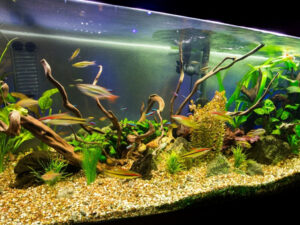There are many different options when it comes to choosing an aquarium. Two of the most popular materials for aquariums are acrylic and glass. But which one is better? There are so many questions that arise in our minds when it comes to deciding the material you want your aquarium to be.
Many experienced fish keepers may know the difference between the two and will know what works best for them. Still, on the contrary, a beginner might not be sure about anything, and choosing between these two can be overwhelming! But don't worry; we got you covered.
Initially, it may seem like they have similar features. Both can hold gallons of water. They are both perfect for aquatic plants and fish. The differences are in material, durability, shape, weight, and other points discussed later.
In this article, we will discuss what acrylic Vs glass aquariums are, the pros and cons of both glass and acrylic aquariums, which is better, and for whom, etc., to make an informed decision about which one is better for you.
By the end of the article, you should have a clear opinion about what is best for you and the fish and plants you want in your aquarium. So let us get started!
Table of Contents
Acrylic Vs Glass Aquarium
Here we will share the difference between Acrylic and Glass aquariums.
Glass Aquariums
As the name suggests, glass aquariums are made of glass. The most common type is the rectangular fish tank. They can be made from different types of glass, such as tempered or borosilicate glass. Tempered glass is more common because it is less expensive and more durable.
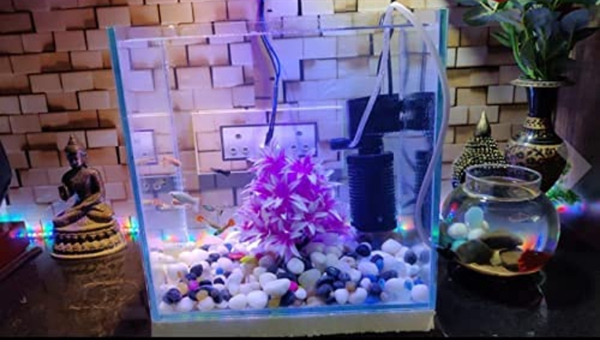
A borosilicate glass tank is less likely to shatter than a tempered glass tank but is also more expensive.
Here are some main features of a good glass aquarium tank and why it is an excellent option to choose for your tank :
Clarity
One of the best things about glass is that it is very clear, whether old or new. This means that your fish and plants will be visible from all angles, and you will have a great view of your aquarium.
Let us assume that, for some reason, if one side of your aquarium becomes less clear, you can replace that one pane rather than the entire tank.
Old aquariums can be very useful. If there are issues with your old tank, you can buy a new one, but do not discard the old one. You can take good parts out of your old tank, keep them as spares, and use them. This will save a lot of money and is suitable for our environment.
Also, check Red Devil Cichlid 101: Best Detailed Care Guide
Weight
Glass tanks are usually heavier than acrylic tanks. This is because glass is a denser material. A 55-gallon glass aquarium can weigh up to 160 pounds when empty and up to 700 pounds when filled with water. This weight can be a problem if you often plan to move your aquarium or live in an earthquake-prone area.
Moving the glass tank can be a nightmare if you are shifting home and must transport your glass aquarium to a new location. You have to be careful not to break it on the way. The glass tank will shatter into many pieces when dropped. These tanks are more at risk of breaking under transportation than acrylic tanks.
If you have a small tank, you must also empty the whole tank and remove all the fish and other accessories and equipment to make it light enough to be movable. This can be a total disaster, and the chances of any mishappening are higher.
Also, check Red Empress Cichlid 101: Best Care Guide
Light Distortion
Light bends in unusual and beautiful ways, changing the final image slightly when passing through the glass. And when water is added to a glass tank, the image becomes even more distorted. The objects may look slightly different in shape and size, but that is not a big deal.
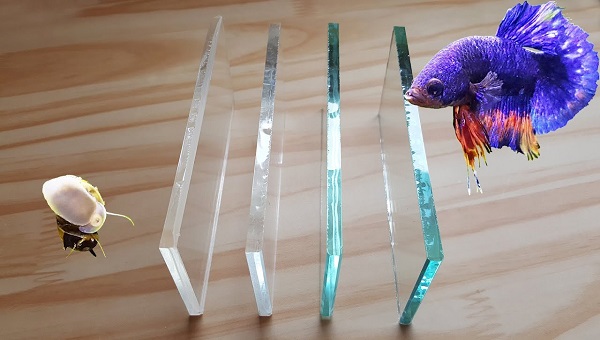
This is not a problem if you like how your fish look when seen through water, but it can be an issue if you try to take pictures of your fish or plants.
The distortion caused by light passing through glass can make your fish look different from real life. This is called light refraction; overall, it is not a big problem.
This is barely visible in a home aquarium as they are small in size, and the glass isn't thick enough, but when you visit a large public aquarium that is very deep and is made of very thick glass, this effect is visible.
Stand For Your Glass Tank
When you buy a glass aquarium, it will come with a stand. This stand is designed to support the weight of your tank and keep it level. A good quality stand will have leveling feet that can be adjusted to ensure your tank is level, even if your floors are not.
The stand should also have a lip or edge to keep water from spilling out if your tank springs a leak. It would help if you made sure that the stand you choose is strong enough to support the weight of your glass aquarium when it is full of water.
A 55-gallon glass aquarium can weigh up to 700 pounds, so you need to ensure that the stand can support that much weight.
On the other hand, glass tanks are the only solution if you are looking for an open-top aquarium. They are sturdy and safe to be kept open at the top without a lid. Since glass is solid and rigid, it will require less support from its base and lid.
You may also check Cardinal Sulawesi Shrimp 101: Care Guide & Breeding Guide
Strength
Glass is a solid and durable material. The strength depends upon the thickness of the glass. The higher the tank's water volume, the thicker the glass. Let us assume that if you knock the glass tank down, drop it, or cause any damage; it will show signs of weakening or even breaking faster than an acrylic tank.
Cracks And Scratches
Glass is a rugged and robust material that can still be scratched or cracked. It would be best to be careful not to scratch the sides or bottom when cleaning your glass aquarium. A glass aquarium can also crack if it is dropped or if something heavy is dropped.
When a glass aquarium cracks, it needs to be replaced. You can't repair a glass aquarium quickly. Ensure you put your glass tank in a safe place so the tank doesn't get knocked down and your fish doesn't get stressed.
Aesthetics
Glass tanks have a classic look that many people love. They are sleek and elegant and can make a great addition to any room. Glass aquariums come in various sizes, so you can find one that will fit perfectly in your available space.
However, most tanks are either rectangular or square when shaping. You can also get a curved glass tank, but you will get irritated by the distorted images. You might curve lass tank look cool, but it is not a great choice.
Also, check Cherry Shrimp Care Guide: Appearance, Food & Diet, Lifespan & All
Cost
The cost of a glass aquarium will vary depending on the size and shape of the tank. Glass aquariums are generally more expensive than acrylic aquariums. Still, they can last a lifetime if they are correctly cared for.
Pros and Cons of Glass Aquariums
| Pros | Cons |
| They are classic in look and elegant | Glass can crack easily |
| They come in a variety of sizes to fit any space | Limited shapes available |
| Glass is sturdy | |
| Scratch-resistant |
Acrylic Aquariums
Like glass, acrylic is a transparent material that can make aquariums. Unlike glass, acrylic is a plastic material that is formed into sheets.
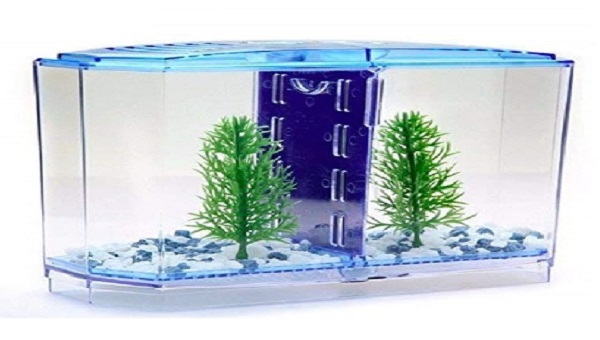
These sheets are then molded into the shape of an aquarium. Just like glass, you can get an acrylic tank in different sizes. The key features of acrylic aquariums are discussed below.
Clarity
When it comes to clarity, acrylic is the clear winner. Acrylic aquariums are much more transparent than glass aquariums. This is because acrylic doesn't have the green tint that glass does. The lack of a tint means better viewing your fish and their underwater home.
The clarity of acrylic aquariums has started deteriorating over the years. As time passes, you will see it start yellowing. There are scratches, and it starts to look very unpleasant.
This is very normal and cannot be avoided as the chemicals in the acrylic react to many factors, such as light and any chemicals added to the tank. It reacts to both natural and artificial light. You cannot avoid this but position your bank away from bright sunlight.
You should also consider the type of fish you are keeping and the plants you are growing. If the fish requires long periods of bright light, this discoloration will happen much faster. The discoloration will be much slower if you keep plants and fish requiring dimmer lights.
Check Clown Loach Care: Appearance, Tank Mates, Lifespan, Breeding & All
Weight
Acrylic is much lighter than glass, so an acrylic aquarium is more accessible to move around than a glass aquarium. They are 4 or 5 times lighter than glass tanks. It will also make the transporting process a lot easier. This is especially important if you have a large tank.
Acrylic tanks are also less likely to break if dropped because they are lighter and more flexible than glass tanks.
Scratch Resistance
Acrylic is a soft material, so it can easily be scratched. It would be best to avoid scratching the sides or bottom when cleaning an acrylic aquarium. Acrylic can also crack if it is dropped or something heavy is dropped on it.
When an acrylic aquarium cracks, it needs to be replaced. You can't repair an acrylic aquarium quickly. Always make sure that you use a soft cloth when cleaning your acrylic aquarium.
Also, check Jaguar Cichlids Care: Appearance, Lifespan
Light Distortion
Acrylic aquariums tend to distort light. This means the fish and plants inside the tank might look different from real life. This is because the light bends as it passes through the acrylic. The distortion is more pronounced in larger tanks.
Stand For Your Acrylic Tank
When finding a stand for your acrylic aquarium, you might have more difficulty than if you had a glass aquarium. This is because most stands are made of glass tanks. You can find stands for acrylic tanks, but they might be more expensive.
If you already have a stand for a glass tank, you can use it for an acrylic tank. Just ensure the stand is strong enough to support the tank's weight. You might need to reinforce the stand if it is not made for an acrylic tank.
Strength And Safety
Acrylic is a much weaker material than glass. It can easily be bent, molded, or even shattered. This makes acrylic aquariums less safe than glass aquariums. An acrylic aquarium might not be the best option if you have small children or pets.
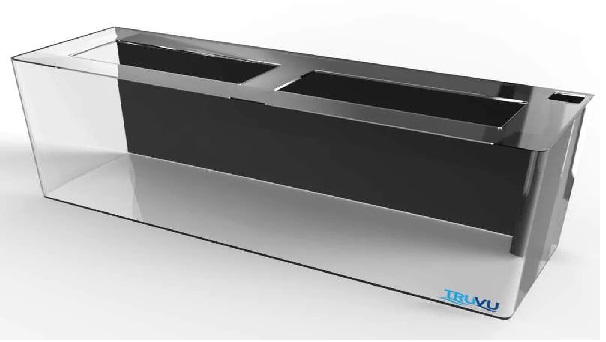
The thickness of your acrylic tank of 20 gallons is less than a glass tank that holds the same amount of water. Glass tanks are bulkier than acrylic tanks.
Also, check Black Ghost Knife Fish 101: Best Detailed Guide & More
Aesthetics
Acrylic aquariums have a modern look that glass aquariums don't have. They are available in a variety of shapes and sizes. You can even get an acrylic aquarium custom-made to fit your specific needs. This makes them highly demandable as they can fit your style perfectly.
Cost
Acrylic aquariums are generally more expensive than glass aquariums. The cost will vary depending on the size and shape of the tank. The price of an acrylic aquarium can be anywhere from $30 to $500.
Also, check 12 Most Popular Types Of Danios: Appearance, Care, LIfespan & All
Pros and Cons of Acrylic Aquariums
| Pros | Cons |
| They are clear and provide a better view of your fish | They scratch easily |
| They are available in a variety of shapes and sizes | The sides can distort the view of your fish |
They are lightweight, so they are easier to move | They are more expensive than glass aquariums |
Final Thoughts
Acrylic aquariums have their pros and cons. It would help to decide what is most important to you when choosing an aquarium. If you want a better view of your fish, an acrylic aquarium is a way. If you are worried about the safety of your fish, then a glass aquarium might be a better option.
Both choices are great at the end of the day. It would help if you continually keep your and your pet's needs first, no matter what you go for. But ultimately, the choice is up to you.
We hope you enjoyed this article and found it helpful. We expect you to learn a lot about these different types of tanks and will be able to conclude, keeping in mind all the pros and cons of each type.
Thank you so much for reading our article. We hope you will create something best for your fish and plants to thrive in whatever you choose!


